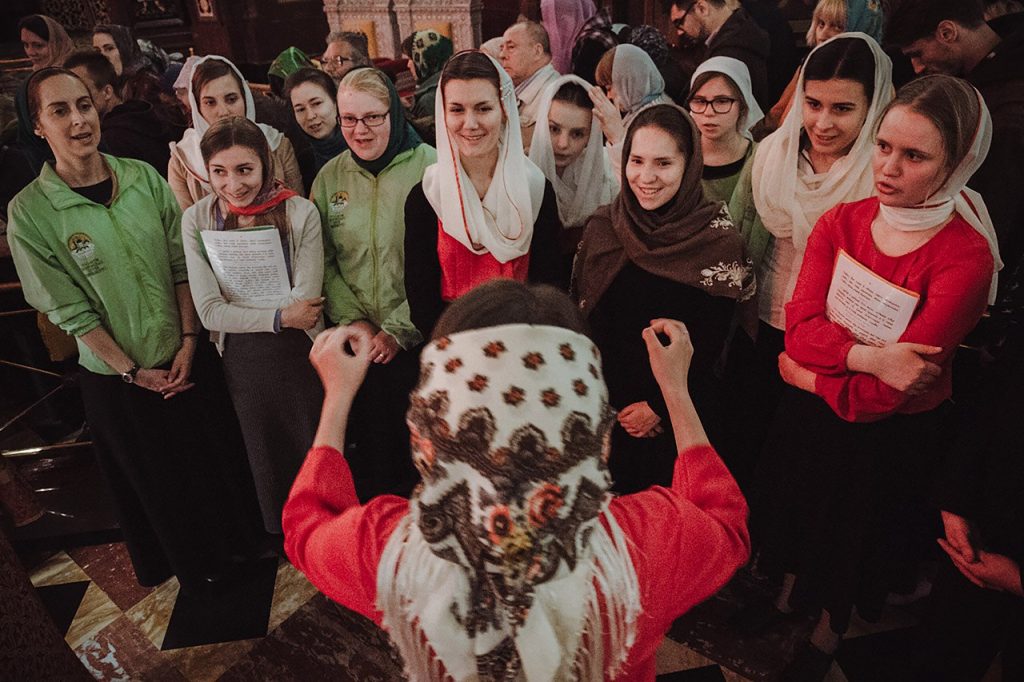
“But what’s my job?” shouted my indignant four-year-old daughter as we cruised down the frozen food aisle. Her nine-year-old sister was reminding me to buy crackers, while her six-year-old sister held the coupons. My youngest would smell out busy work in an instant; her job needed to be something valuable.
“You can use my card to pay at the checkout. I can’t pay for the groceries without you!” Upon having fulfilled her duty, she breathed a deep sigh and reflected, “That was very important.”
When we were in the Anglican Church, we saw men and women, boys and girls serving together in the same capacity. Anglicans have female altar servers, deacons, priests and bishops, and once we saw a female presiding bishop. Where man goes, woman goes. In that setting, my daughters could have served in any capacity they chose. But when we became Orthodox, many of those options were no longer available. As the girls grow in the Church, the same question arises: “But what’s my job?”
The Divine Liturgy is offered for the people of God, and the priest cannot serve it alone. Our first and primary responsibility as Orthodox Christians, whether from inside or outside of the altar doors, is to attend liturgy and add our prayers to the priest’s. If we wish to serve in another capacity, whether male or female, we must all find our gifts and use them to serve our communities. There are limitations on us all, including personalities, physical abilities and, yes, sex. It is particularly important to help our daughters identify the work women do in their parish and to help them see the value and richness of ministry and service that women provide.
So, what can our daughters do? Though my oldest daughter, Adeline, feels a bit wishful about serving at the altar, with guidance she has found equally valuable ways to serve. Consider the need of the parish and the gifts of the girl. Working with your priest you can find ways for girls to take responsibility. If you are in a parish with many young girls, consider starting a ministry just for them. Some churches call this a myrrhbearers ministry. If your parish is smaller, the process is the same but will be more individualized.
Does she bake? She can learn the art of prosphora making, the most necessary of offerings. Learning to create a proper seal and providing the material that becomes the body of Christ is valuable and rewarding. She can ask a different family each week for a list of names the priest will pray for during the liturgy.
Does she love responsibility? Girls can assist with the candles in the narthex and nave. They can bring vigil candles to the iconostasis and monitor candles that are burning low. Is there an artoklasia or a memorial service? Candles need to be lit and tended. At the end of the service, girls can clean out the candle stand, properly disposing of used candles and refilling candle boxes. If she wishes to feel official, she can wear a white dress as she performs her duties.
Does she love music? The choir or chant stand may be the place for her. This ministry is of particular interest to our oldest daughter. She helps chant vespers and weekday liturgies and helps at special services. We should not balk at teaching our young girls these skills. They are young, but they are mighty!

Is a pleasant demeanor her gift? She could be a greeter and welcome her church family into Divine Liturgy each week. She can be responsible for handing out bulletins, helping little ones choose a church book to peruse during liturgy and greeting visitors.
Is she artistic? She could consider learning to decorate the icons with flowers or embroidered scarves. The frequent feasts throughout our Church year, as well as Holy Week, bring many opportunities to array our icons, crosses and churches in beauty.
Is she a nurturer? Her ministry may be helping to contain small children and guide them through worship, allowing their parents to participate in a greater capacity. Or perhaps an older parishioner could use a hand during liturgy.
In the community, she can serve by baking for the festival, visiting shut-ins, writing for the parish newsletter or arranging supply drives for any number of organizations. Other than serving at the altar, if there is a need, our girls can meet it. Their roles may not be as visible as their brothers’ in the altar are, but they are nonetheless just as great.
My husband, Rev. Fr. Matthew Moore, often says that the Church is braced on the backs of women. If the women decided they were no longer going to do what they always do, the Church would be in danger of closing! In many churches women are responsible for much of the work done outside the altar, and there would be an incredible vacuum if those offerings ceased. As parents of girls we should always point out the important work that women are doing in the Church. If we assign value to the many ministries outside the altar, our daughters will as well. They will see their contributions as the beautiful, equally important offerings that they are.





Women are indeed the backbone of the Church, and have been since the Holy Myrrhbearers! Yet, it’s men who still have all the power and get all the attention. Why?